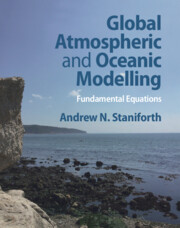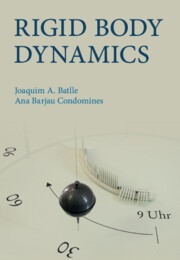Refine search
Actions for selected content:
8126 results in Fluid dynamics and solid mechanics
EXPLICIT NORDSIECK SECOND DERIVATIVE GENERAL LINEAR METHODS FOR ODES
- Part of
-
- Journal:
- The ANZIAM Journal / Volume 64 / Issue 1 / January 2022
- Published online by Cambridge University Press:
- 25 April 2022, pp. 69-88
-
- Article
- Export citation
1 - Particle Dynamics
-
- Book:
- Rigid Body Dynamics
- Published online:
- 21 March 2022
- Print publication:
- 14 April 2022, pp 1-78
-
- Chapter
-
- You have access
- HTML
- Export citation
Preface
-
- Book:
- Rigid Body Dynamics
- Published online:
- 21 March 2022
- Print publication:
- 14 April 2022, pp ix-xi
-
- Chapter
- Export citation
7 - Lagrange’s Equations
-
- Book:
- Rigid Body Dynamics
- Published online:
- 21 March 2022
- Print publication:
- 14 April 2022, pp 463-503
-
- Chapter
- Export citation
Abbreviations
-
- Book:
- Rigid Body Dynamics
- Published online:
- 21 March 2022
- Print publication:
- 14 April 2022, pp xii-xii
-
- Chapter
- Export citation
Bibliography
-
- Book:
- Rigid Body Dynamics
- Published online:
- 21 March 2022
- Print publication:
- 14 April 2022, pp 579-579
-
- Chapter
- Export citation
Reviews
-
- Book:
- Rigid Body Dynamics
- Published online:
- 21 March 2022
- Print publication:
- 14 April 2022, pp ii-ii
-
- Chapter
- Export citation
Further Reading
-
- Book:
- Rigid Body Dynamics
- Published online:
- 21 March 2022
- Print publication:
- 14 April 2022, pp 579-579
-
- Chapter
- Export citation
5 - Work–Energy Theorem
-
- Book:
- Rigid Body Dynamics
- Published online:
- 21 March 2022
- Print publication:
- 14 April 2022, pp 316-405
-
- Chapter
- Export citation
8 - Introduction to Percussive Dynamics
-
- Book:
- Rigid Body Dynamics
- Published online:
- 21 March 2022
- Print publication:
- 14 April 2022, pp 504-578
-
- Chapter
- Export citation
2 - Interaction Forces between Rigid Bodies
-
- Book:
- Rigid Body Dynamics
- Published online:
- 21 March 2022
- Print publication:
- 14 April 2022, pp 79-150
-
- Chapter
- Export citation
4 - Vector Theorems
-
- Book:
- Rigid Body Dynamics
- Published online:
- 21 March 2022
- Print publication:
- 14 April 2022, pp 202-315
-
- Chapter
- Export citation
Contents
-
- Book:
- Rigid Body Dynamics
- Published online:
- 21 March 2022
- Print publication:
- 14 April 2022, pp v-viii
-
- Chapter
- Export citation
6 - The Method of Virtual Power
-
- Book:
- Rigid Body Dynamics
- Published online:
- 21 March 2022
- Print publication:
- 14 April 2022, pp 406-462
-
- Chapter
- Export citation
Index
-
- Book:
- Rigid Body Dynamics
- Published online:
- 21 March 2022
- Print publication:
- 14 April 2022, pp 580-584
-
- Chapter
- Export citation
3 - Mass Distribution
-
- Book:
- Rigid Body Dynamics
- Published online:
- 21 March 2022
- Print publication:
- 14 April 2022, pp 151-201
-
- Chapter
- Export citation
Copyright page
-
- Book:
- Rigid Body Dynamics
- Published online:
- 21 March 2022
- Print publication:
- 14 April 2022, pp iv-iv
-
- Chapter
- Export citation

Global Atmospheric and Oceanic Modelling
- Fundamental Equations
-
- Published online:
- 08 April 2022
- Print publication:
- 28 April 2022
HOPF BIFURCATION ANALYSIS OF A FRACTIONAL-ORDER HOLLING–TANNER PREDATOR-PREY MODEL WITH TIME DELAY
- Part of
-
- Journal:
- The ANZIAM Journal / Volume 64 / Issue 1 / January 2022
- Published online by Cambridge University Press:
- 05 April 2022, pp. 23-39
-
- Article
- Export citation

Rigid Body Dynamics
-
- Published online:
- 21 March 2022
- Print publication:
- 14 April 2022





